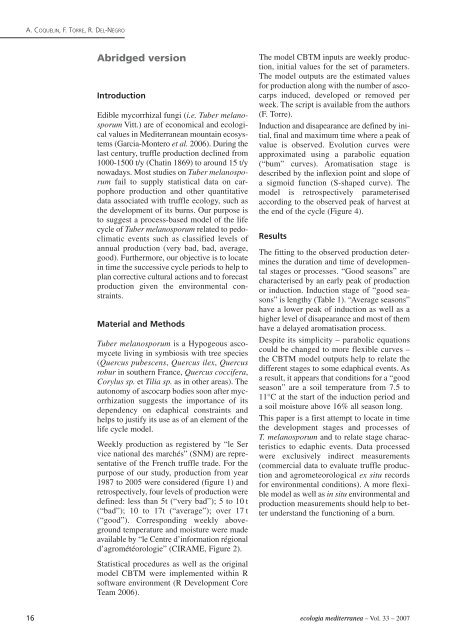Revue internationale d'écologie méditerranéenne Mediterranean ...
Revue internationale d'écologie méditerranéenne Mediterranean ...
Revue internationale d'écologie méditerranéenne Mediterranean ...
You also want an ePaper? Increase the reach of your titles
YUMPU automatically turns print PDFs into web optimized ePapers that Google loves.
A. COQUELIN, F. TORRE, R. DEL-NÉGRO<br />
16<br />
Abridged version<br />
Introduction<br />
Edible mycorrhizal fungi (i.e. Tuber melanosporum<br />
Vitt.) are of economical and ecological<br />
values in <strong>Mediterranean</strong> mountain ecosystems<br />
(Garcia-Montero et al. 2006). During the<br />
last century, truffle production declined from<br />
1000-1500 t/y (Chatin 1869) to around 15 t/y<br />
nowadays. Most studies on Tuber melanosporum<br />
fail to supply statistical data on carpophore<br />
production and other quantitative<br />
data associated with truffle ecology, such as<br />
the development of its burns. Our purpose is<br />
to suggest a process-based model of the life<br />
cycle of Tuber melanosporum related to pedoclimatic<br />
events such as classified levels of<br />
annual production (very bad, bad, average,<br />
good). Furthermore, our objective is to locate<br />
in time the successive cycle periods to help to<br />
plan corrective cultural actions and to forecast<br />
production given the environmental constraints.<br />
Material and Methods<br />
Tuber melanosporum is a Hypogeous ascomycete<br />
living in symbiosis with tree species<br />
(Quercus pubescens, Quercus ilex, Quercus<br />
robur in southern France, Quercus coccifera,<br />
Corylus sp. et Tilia sp. as in other areas). The<br />
autonomy of ascocarp bodies soon after mycorrhization<br />
suggests the importance of its<br />
dependency on edaphical constraints and<br />
helps to justify its use as of an element of the<br />
life cycle model.<br />
Weekly production as registered by “le Ser<br />
vice national des marchés” (SNM) are representative<br />
of the French truffle trade. For the<br />
purpose of our study, production from year<br />
1987 to 2005 were considered (figure 1) and<br />
retrospectively, four levels of production were<br />
defined: less than 5t (“very bad”); 5 to 10 t<br />
(“bad”); 10 to 17t (“average”); over 17 t<br />
(“good”). Corresponding weekly aboveground<br />
temperature and moisture were made<br />
available by “le Centre d’information régional<br />
d’agrométéorologie” (CIRAME, Figure 2).<br />
Statistical procedures as well as the original<br />
model CBTM were implemented within R<br />
software environment (R Development Core<br />
Team 2006).<br />
The model CBTM inputs are weekly production,<br />
initial values for the set of parameters.<br />
The model outputs are the estimated values<br />
for production along with the number of ascocarps<br />
induced, developed or removed per<br />
week. The script is available from the authors<br />
(F. Torre).<br />
Induction and disapearance are defined by initial,<br />
final and maximum time where a peak of<br />
value is observed. Evolution curves were<br />
approximated using a parabolic equation<br />
(“bum” curves). Aromatisation stage is<br />
described by the inflexion point and slope of<br />
a sigmoid function (S-shaped curve). The<br />
model is retrospectively parameterised<br />
according to the observed peak of harvest at<br />
the end of the cycle (Figure 4).<br />
Results<br />
The fitting to the observed production determines<br />
the duration and time of developmental<br />
stages or processes. “Good seasons” are<br />
characterised by an early peak of production<br />
or induction. Induction stage of “good seasons”<br />
is lengthy (Table 1). “Average seasons”<br />
have a lower peak of induction as well as a<br />
higher level of disapearance and most of them<br />
have a delayed aromatisation process.<br />
Despite its simplicity – parabolic equations<br />
could be changed to more flexible curves –<br />
the CBTM model outputs help to relate the<br />
different stages to some edaphical events. As<br />
a result, it appears that conditions for a “good<br />
season” are a soil temperature from 7.5 to<br />
11°C at the start of the induction period and<br />
a soil moisture above 16% all season long.<br />
This paper is a first attempt to locate in time<br />
the development stages and processes of<br />
T. melanosporum and to relate stage characteristics<br />
to edaphic events. Data processed<br />
were exclusively indirect measurements<br />
(commercial data to evaluate truffle production<br />
and agrometeorological ex situ records<br />
for environmental conditions). A more flexible<br />
model as well as in situ environmental and<br />
production measurements should help to better<br />
understand the functioning of a burn.<br />
ecologia mediterranea – Vol. 33 – 2007
















